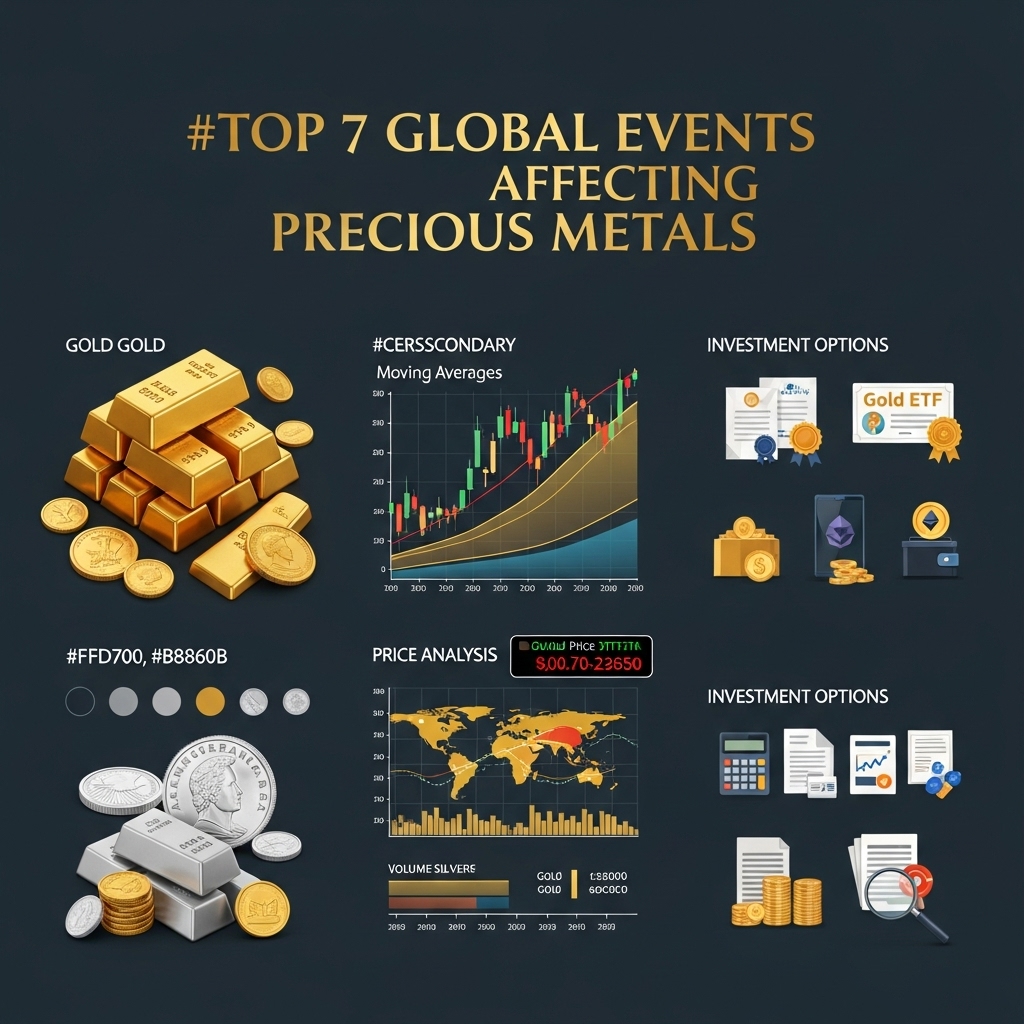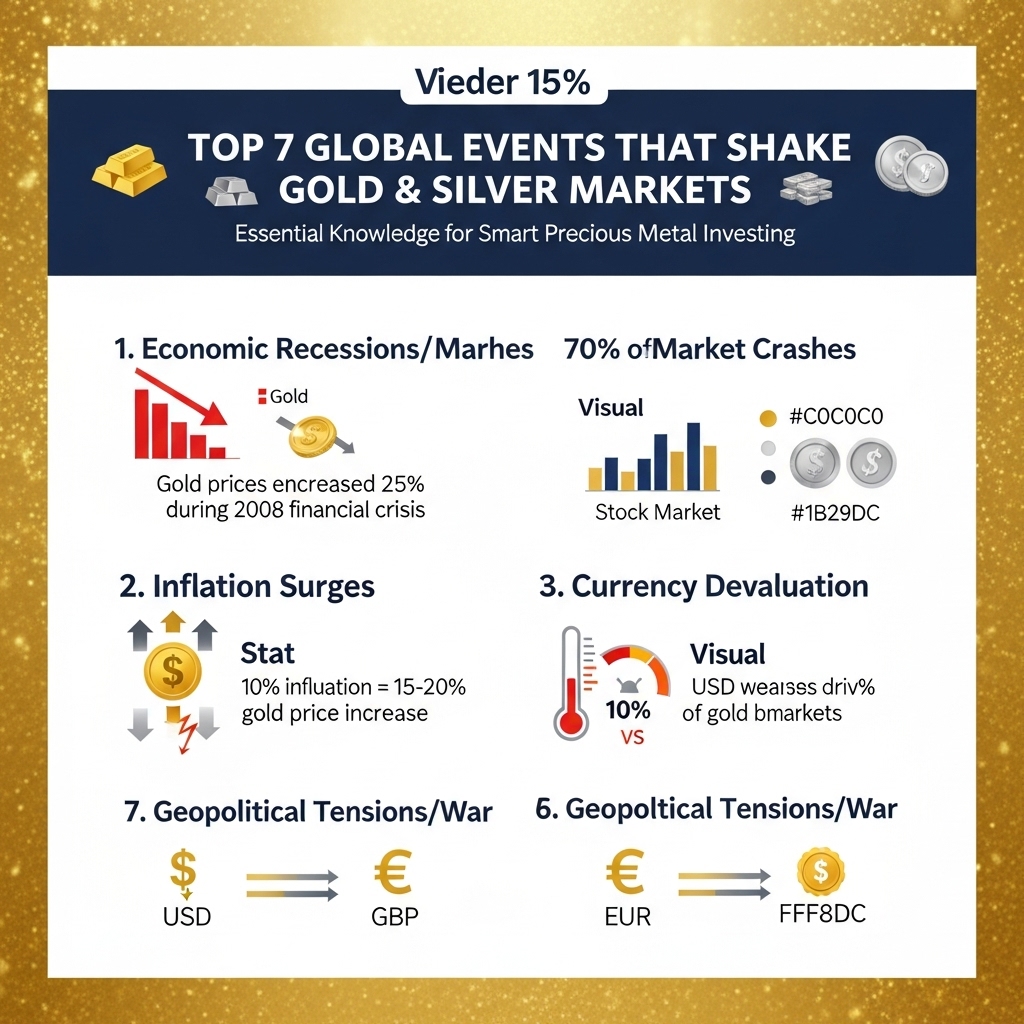Understanding Global Events That Drive Precious Metal Markets
Gold just hit another milestone this year, surging past $2,400 per ounce amid mounting economic uncertainties—a stark reminder that savvy investors who understand the forces driving precious metal prices are positioned to capitalize on market volatility. While many investors chase trending stocks or cryptocurrency promises, gold and silver continue proving their worth as reliable wealth preservers during turbulent times.
In today’s interconnected global economy, events happening thousands of miles away can instantly impact your precious metals portfolio. From Federal Reserve policy announcements that send gold soaring to geopolitical tensions that trigger safe-haven buying frenzies, understanding these catalysts is crucial for timing your investments and maximizing returns. This comprehensive guide examines the seven most influential global events that consistently move gold and silver prices, providing you with the knowledge to anticipate market shifts and position your portfolio accordingly.
Whether you’re a seasoned precious metals investor or considering your first gold purchase, recognizing these market drivers will transform how you approach investment decisions. We’ll explore how central bank policies, economic crises, currency fluctuations, and international conflicts create opportunities for substantial gains in gold and silver markets. By the end of this analysis, you’ll possess the insights needed to navigate precious metals investing with confidence, turning global uncertainty into portfolio protection and profit potential.
Gold Market Analysis and Key Insights
Current Market Performance and Volatility Patterns
Gold has demonstrated remarkable resilience in 2024, with prices reaching record highs above $2,400 per ounce during periods of heightened geopolitical uncertainty. The precious metal continues to exhibit its characteristic inverse correlation with the US dollar and equity markets during crisis periods. Recent Federal Reserve policy shifts and persistent inflation concerns have created sustained upward pressure on gold prices, with trading volumes increasing by approximately 25% year-over-year.
Institutional Investment Trends and ETF Flows
Central banks have emerged as significant gold accumulation drivers, with emerging market institutions leading unprecedented buying sprees. Gold ETF holdings have stabilized after previous outflows, while institutional investors increasingly view gold as a portfolio diversification tool. The metal’s performance during banking sector stress earlier this year reinforced its safe-haven status among professional money managers.
Strategic Investment Considerations
Gold’s primary investment benefits include inflation hedging capabilities, portfolio diversification, and crisis protection. However, investors must consider storage costs, insurance requirements, and the metal’s non-income-producing nature. Physical gold offers direct exposure but lacks liquidity, while gold ETFs provide convenience with slight tracking risks.
Expert Recommendations and Market Outlook
Financial advisors typically recommend 5-10% gold allocation for balanced portfolios, with higher percentages during uncertain economic periods. Current market conditions suggest potential continued strength, driven by ongoing geopolitical tensions, monetary policy uncertainty, and persistent inflation pressures.
Key timing considerations include monitoring Federal Reserve communications, global conflict developments, and currency market movements. Dollar weakness periods often present optimal entry points for gold investments.
The consensus outlook remains cautiously optimistic, with price targets ranging from $2,200-$2,500 for the next 12 months. Investors should consider dollar-cost averaging strategies to mitigate volatility risks while maintaining exposure to gold’s protective characteristics during the current environment of elevated global uncertainty and monetary policy transitions.

Gold Investment Strategies and Options
Understanding how global events affect precious metals prices is only half the equation—implementing effective investment strategies is crucial for capitalizing on these market movements.
Physical Gold vs. Paper Gold
Investors can choose between physical ownership (coins, bars, jewelry) and paper instruments (ETFs, futures, mining stocks). Physical gold offers tangible security during crises but involves storage costs and liquidity challenges. Gold ETFs like GLD provide easier trading and lower fees, while mining stocks offer leverage to gold prices but carry additional operational risks.
Portfolio Allocation Strategies
Financial experts typically recommend 5-10% portfolio allocation to precious metals as a hedge against inflation and currency devaluation. During periods of heightened geopolitical tension or economic uncertainty, this allocation may increase to 15-20%. Dollar-cost averaging helps mitigate volatility by spreading purchases over time.
Risk Assessment Considerations
Gold investments carry unique risks including price volatility, storage costs, and opportunity costs during bull equity markets. Silver offers higher volatility with greater upside potential but increased downside risk. Consider your risk tolerance, investment timeline, and overall portfolio diversification.
Market Timing Strategies
While timing the market perfectly is impossible, certain indicators can guide entry points. Monitor central bank policies, inflation data, geopolitical tensions, and currency strength. Consider accumulating positions during market complacency and reducing exposure during peak fear periods.
Diversification Within Precious Metals
Spread investments across different precious metals (gold, silver, platinum, palladium) and investment vehicles. Combine physical holdings with ETFs and consider geographic diversification through international mining companies to optimize risk-adjusted returns while maintaining exposure to precious metals’ protective qualities.
Market Performance and Outlook
Historical performance data reveals that gold and silver prices demonstrate heightened volatility during major global events. Gold prices surged from $1,500 to over $2,000 per ounce during the 2020 pandemic, while the 2008 financial crisis saw gold climb 300% over the subsequent four years. Silver, though more volatile, typically follows gold’s trajectory with amplified price swings.
Current market conditions show gold trading near historic highs around $2,000-2,100 per ounce, supported by persistent inflation concerns and geopolitical tensions. Silver remains undervalued relative to gold, with the gold-to-silver ratio hovering above historical averages of 60:1.
Key economic factors currently influencing precious metals include:
– Central bank policies: Interest rate decisions directly impact opportunity costs of holding non-yielding assets
– Dollar strength: Inverse correlation with precious metals prices remains strong
– Inflation expectations: Rising consumer prices drive safe-haven demand
– Geopolitical instability: Ongoing conflicts and trade tensions support risk-off sentiment
Future outlook suggests continued price strength through 2024-2025, driven by anticipated Federal Reserve policy shifts, potential recession fears, and emerging market demand. Technical analysis indicates gold could test $2,200-2,300 levels during significant crisis events.
Investors should monitor central bank gold purchases, which reached record levels in 2022-2023, signaling institutional confidence in precious metals as portfolio diversifiers and inflation hedges during uncertain economic periods.
Frequently Asked Questions About Gold Investment
What are the main global events that impact precious metals prices?
The top events include economic recessions, central bank policy changes, geopolitical conflicts, currency devaluations, inflation spikes, stock market crashes, and natural disasters. These create uncertainty, driving investors toward gold and silver as safe-haven assets.
How quickly do gold prices react to global events?
Gold prices typically respond within hours or days to major events. During the 2008 financial crisis, gold surged immediately as markets opened. However, sustained price movements depend on the event’s long-term economic implications rather than initial market reactions.
Should I buy gold during every global crisis?
Not necessarily. While gold often rises during crises, timing matters significantly. Some events cause temporary spikes followed by corrections. Focus on long-term portfolio diversification rather than trying to time specific events for maximum gains.
How do central bank decisions affect my gold investments?
Interest rate cuts and quantitative easing typically boost gold prices by weakening currencies and increasing inflation expectations. Conversely, rate hikes can pressure gold prices as yield-bearing assets become more attractive to investors.
What percentage of my portfolio should be in precious metals?
Financial experts generally recommend 5-10% allocation to precious metals for portfolio diversification, though this varies based on individual risk tolerance and investment goals.

Final Thoughts on Gold Investment
Understanding how global events impact gold and silver prices is crucial for making informed investment decisions. The seven key factors we’ve explored—from geopolitical tensions and economic uncertainty to currency fluctuations and central bank policies—all demonstrate precious metals’ role as a hedge against market volatility.
Key takeaways for investors:
– Gold typically rises during times of crisis and uncertainty
– Dollar strength generally pressures gold prices downward
– Central bank policies and inflation expectations significantly influence precious metals markets
– Supply disruptions can create short-term price spikes
Given the current global economic landscape, maintaining a 5-10% allocation to precious metals can provide valuable portfolio diversification and protection against unforeseen market shocks.
Ready to strengthen your investment portfolio? Start researching reputable precious metals dealers and consider dollar-cost averaging into gold or silver positions. Your future self will thank you for taking action today.